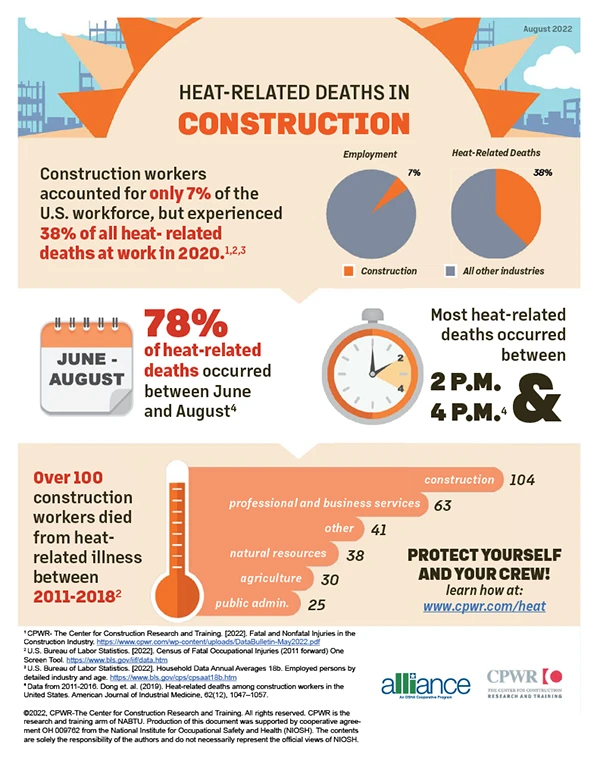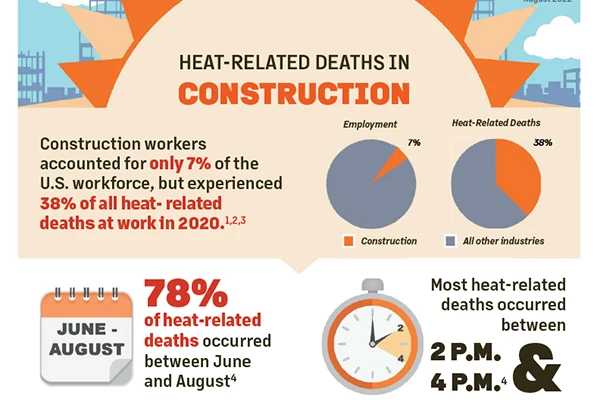 From The Ironworker magazine — By Steve Rank —
From The Ironworker magazine — By Steve Rank —
Who is affected by heat illness?
Any worker exposed to hot and humid conditions is at risk of heat illness, especially those doing the heavy work many ironworkers perform daily. Some workers could be at greater risk if they have not built up a tolerance to hot conditions, including new workers, temporary workers, or those returning to work after a week or more off.
Reinforcing steel installation and carrying and installing rebar on decks and walls is a common work activity ironworkers perform that can produce much higher temperatures in full sun conditions and hot and humid conditions.
What is heat illness and how does it happen?
e body normally cools itself naturally by sweating, but sweating is not enough during hot weather, especially with high humidity. Body temperature can rise quickly to dangerous levels without proper precautions, such as drinking water frequently and access to shade or air conditioning. Heat stroke requires immediate medical attention.
How can heat illness be prevented?
To prevent heat illness, employers should establish a heat illness prevention program and work with their foremen to recognize the signs and symptoms of heat illness. Employers should provide water and shade; gradually increase workloads and allow more frequent breaks for new workers or workers who have been away for a week or more; modify work schedules as necessary; plan for emergencies and train workers about heat-related illness symptoms and prevention; and monitor workers for signs of illness.
Remember these three simple words: water, rest, shade. Taking these precautions can mean the difference between life and death.
Common heat illness symptoms
- Heavy sweating
- Painful muscle cramps
- Extreme weakness and/or fatigue
- Nausea and/or vomiting
- Dizziness and/or headache
- Body temperature normal or slightly high
- Fainting
- Pulse fast and weak
- Breathing fast and shallow
- Clammy, pale, cool, and/or moist skin
Common heat stroke symptoms
- High body temperature (above 103°F)
- Hot, red, dry or moist skin
- Rapid and strong pulse
- Possible unconsciousness
Heat-related illness and fatality prevention
- Drink water every 15 minutes, even if you are not thirsty
- Move to a cooler location, rest in the shade
- Apply cool, wet cloths on as much of your body as possible
- Lie down and loosen your clothing
- Wear a hat and light-colored clothing
- Learn the signs of heat illness and what to do in an emergency
- Keep an eye on coworkers
- “Easy does it” on the first workdays in the heat — workers need to get used to it
What you should do if you see a member with heat illness symptoms
- Call 911 immediately — this is a medical emergency
- Move the person to a cooler environment
- Reduce the person’s body temperature with cool cloths or even pouring water on them
- Do NOT give fluids
Steve Rank is the Executive Director of Safety & Health for the Ironworkers International, and a member of Iron Workers Local #10 in Kansas City, MO.

Suncoast Reinforcing is hiring!
If you’re looking for work, contact Suncoast Reinforcement for information about current openings.
We’re nearly always hiring skilled ironworkers, supervisors and helpers.


0 Comments